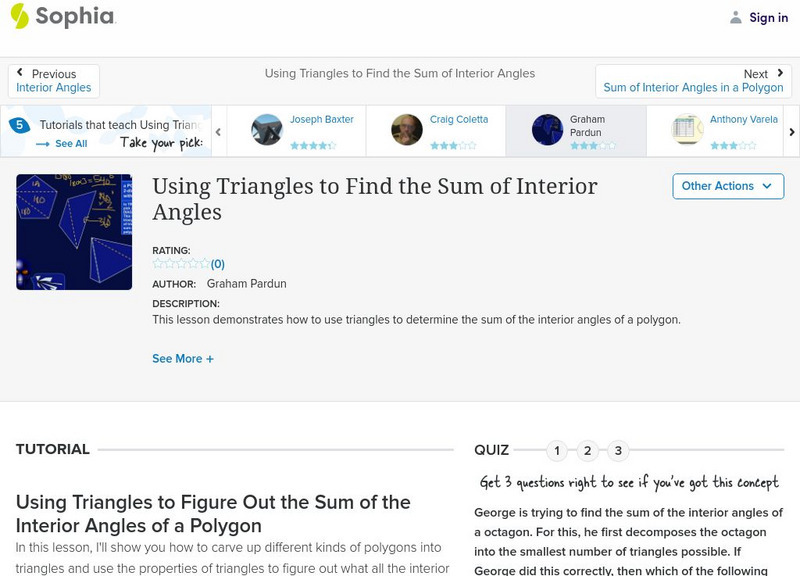NUMBEROCK
Polygons
Alan kite surfs, skateboards, bikes, dives, and explores space as he learns about Polygons. These shapes surround Alan in his daily life, and he is so excited to give you a tour of real-world polygons! The smooth beat and positive vibes...
Curated Video
An Introduction to Polygons
This video covers the names of polygons and 2D shape properties. Learn the difference between regular & irregular polygons and the names of these polygons such as pentagon and hexagon.
NUMBEROCK
Polygons
Alan kite surfs, skateboards, bikes, dives, and explores space as he learns about Polygons. These shapes surround Alan in his daily life, and he is so excited to give you a tour of real-world polygons! The smooth beat and positive vibes...
FuseSchool
What Are Polygons
CREDITS Animation & Design: Peter van de Heuvel Narration: Lucy Billings Script: Lucy Billings The word polygon comes from Greek. Poly means “many” and Gon means “angles”. Polygon = many angles. Polygons are 2-dimensional shapes, that...
Curated Video
GCSE Maths - Regular Polygons #99
This video covers what we mean by 'regular polygons' and the different types you need to know. We also cover how many lines of symmetry and rotational symmetry they each have. This video is suitable for maths courses around the world....
Crash Course
3D Graphics: Crash Course Computer Science
Today we’re going to discuss how 3D graphics are created and then rendered for a 2D screen. From polygon count and meshes, to lighting and texturing, there are a lot of considerations in building the 3D objects we see in our movies and...
Curated Video
Understanding Lines of Symmetry
This video explains lines of symmetry of 2D shapes including triangles, quadrilaterals and regular polygons. Practice questions and answers are at the end of the video.
Curated Video
Identifying and Sorting Pentagons
In this video, students learn how to identify and sort pentagons at the Shape Warehouse by examining their attributes. They are taught that a polygon is a closed figure with straight sides, and a pentagon specifically has five sides and...
Curated Video
Identifying and Sorting Hexagons
In this video, workers at the Shape Warehouse learn how to identify and sort hexagons to their correct door. They review the concept of polygons and examine the attributes of hexagons, such as having six sides and six angles. Through...
Zach Star
These changed how I think about higher dimensions
These changed how I think about higher dimensions
Corbett Maths
Names of 2D Shapes
Two-d or not two-d? That's not really the question because the figures here are all two-dimensional. Learners identify the names of polygons, starting with triangles and ending with decagons. The video also describes circles and...
Crash Course
3D Graphics: Crash Course Computer Science #27
Graphics can make or break a video or computer game. A thorough installment of the Crash Course Computer Science series describes different types of graphics projections, including orthographic projections and perspective projections. It...
CK-12 Foundation
Ck 12: Elem Math: Overview of Ellipses Trapezoids Rhombi and Polygons
[Free Registration/Login may be required to access all resource tools.] The video draws and defines an ellipse, trapezoid, rhombus, and polygon.
Khan Academy
Khan Academy: Classifying Shapes by Lines and Angles
Demonstrates how to find what 2D shape matches a set of properties. [3:37]
Khan Academy
Khan Academy: Recognizing Shapes
Discusses how to identify basic 2D shapes by their properties. [6:08]
Khan Academy
Khan Academy: Cousin Fal's Shape Collection
Looks at a collection of 2D shapes and discusses how to identify them based on their properties. [4:19]
Khan Academy
Khan Academy: Classifying Shapes by Line and Angle Types
Explains how to classify 2D shapes based on the properties of their sides and angles. [2:15]
Sophia Learning
Sophia: Using Triangles to Find the Sum of Interior Angles: Lesson 2
This lesson demonstrates how to use triangles to determine the sum of the interior angles of a polygon. It is 2 of 5 in the series titled "Using Triangles to Find the Sum of Interior Angles."
Sophia Learning
Sophia: Using Triangles to Find the Sum of Interior Angles: Lesson 3
This lesson demonstrates how to use triangles to determine the sum of the interior angles of a polygon. It is 3 of 5 in the series titled "Using Triangles to Find the Sum of Interior Angles."
Sophia Learning
Sophia: Using Triangles to Find the Sum of Interior Angles: Lesson 4
This lesson demonstrates how to use triangles to determine the sum of the interior angles of a polygon. It is 4 of 5 in the series titled "Using Triangles to Find the Sum of Interior Angles."










